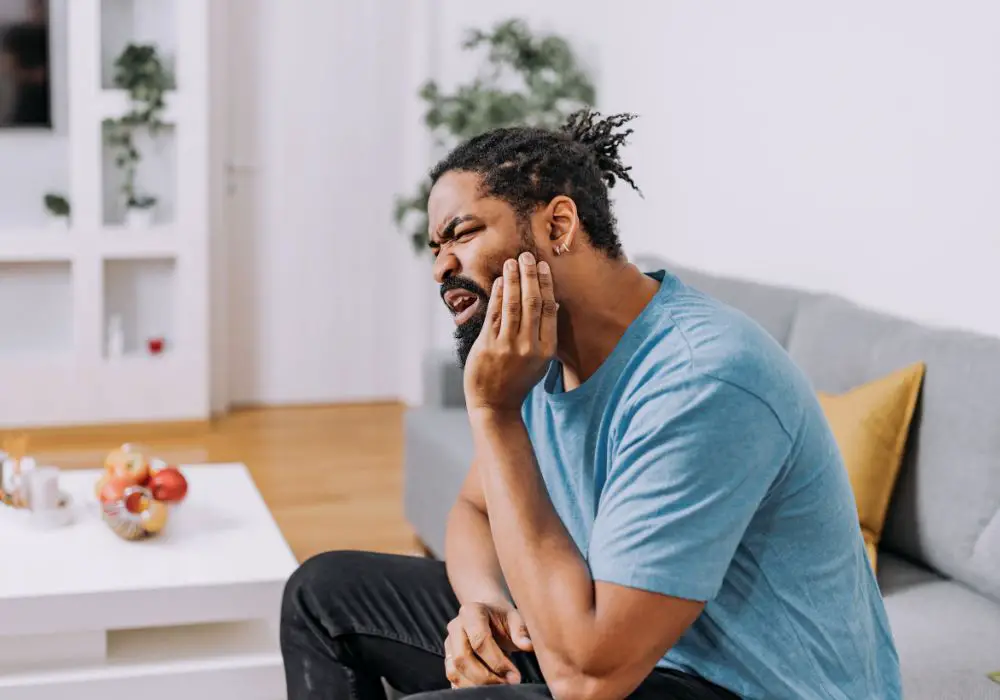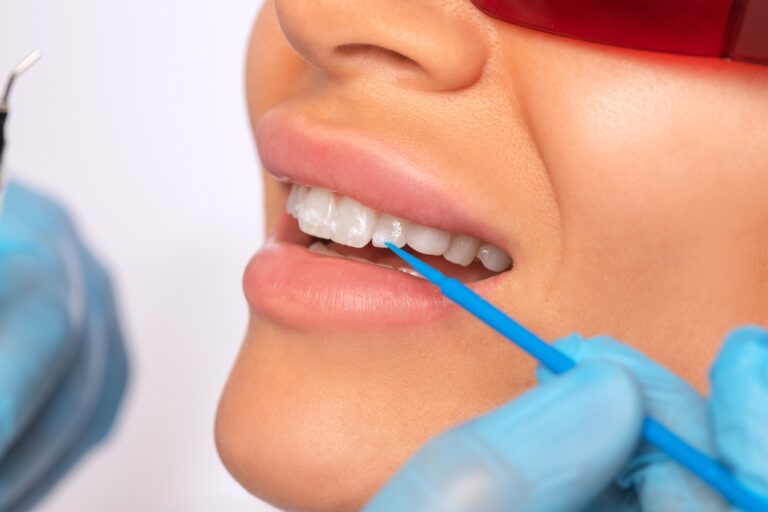It’s very common for a tooth to remain sensitive or painful after receiving a dental filling. Post-filling discomfort is typically mild and temporary, often disappearing within a few weeks as the tooth adjusts and heals. However, ongoing or worsening pain after a filling may sometimes indicate issues needing further treatment.
What causes tooth pain after a dental filling?

There are a number of reasons why a tooth may continue to hurt for days or weeks after being repaired with a filling:
Inflammation and irritation
The process of removing decay and preparing the tooth for a filling often causes some inflammation in the tooth’s pulp and nerve tissue. This is especially true if the cavity was deep and close to the pulp.
The vibration and pressure from dental tools can irritate the nerve, and if decay reached the inner pulp layer, bacteria and infection may be present. This irritation and inflammation takes time to resolve, leading to temporary sensitivity as the tooth’s nerve heals.
Height of the filling
Sometimes a filling may end up with slightly too much material, making the bite too high. This can put intense pressure on the tooth when chewing, causing pain.
The dentist can grind the filling down to adjust its height and take pressure off the tooth if a high bite is suspected.
Post-procedure sensitivity
After having your tooth numbed for a filling, it may remain sensitive for several hours as the anesthetic wears off. Basal (inactive) anesthesia pain can also occur due to the acidity of local anesthetics. This post-procedure sensitivity is temporary.
Heat and cold sensitivity
Teeth often become extra sensitive to hot and cold temperatures after a filling. This occurs because the preparation process can expose microscopic tubules in the dentin of the tooth, allowing hot/cold sensitivity through to the nerve.
Sensitivity to temperature changes should slowly improve within a few weeks, once the tooth has had time to set and adjust to the filling.
Cracked tooth
Sometimes an existing, microscopic crack in the tooth structure spreads due to the vibrations and pressure from removing decay and placing a filling.
This can cause pain when chewing or biting down. If the crack continues to worsen, the tooth may eventually need a root canal or crown placed.
Biting on a numbed tooth
While the local anesthetic is working, patients can accidentally bite their tongue or cheek without feeling it. This trauma can cause lingering soreness that seems like its coming from the filled tooth once the anesthetic wears off.
Referral pain
Dental pain from one tooth can sometimes be felt in another tooth. So in some cases, pain after a filling may actually be coming from a different problematic tooth.
Your dentist can determine where the real source of discomfort is through testing.
When to see your dentist about post-filling pain
You should make an appointment with your dentist promptly if:
- Pain and sensitivity persists longer than 3-4 weeks after the filling procedure
- Post-filling discomfort seems to get significantly worse over time rather than improving
- Pain is severe enough to disrupt sleep
- The tooth becomes extremely sensitive to hot or cold temperatures
- Swelling develops in the gums around the treated tooth
- You develop unexpected pain when biting down or chewing
Leaving post-filling tooth pain untreated for too long risks more serious problems like infection, so it’s important to consult your dentist if discomfort continues.
Diagnosing the cause of lingering pain after a filling

During your appointment, your dentist will perform a thorough examination and assessment to try to pinpoint why your tooth still hurts after receiving the filling:
Medical history
They’ll ask about your medical history, when you first noticed the pain, and what specific symptoms you’re experiencing. Details like symptoms worsening at night can provide helpful clues.
Dental examination
The dentist will examine the tooth visually, testing it with dental instruments for defects, cracks, gaps around filling margins, swelling, or tenderness. They’ll also assess your bite alignment and check for high spots.
Temperature sensitivity testing
They may test the tooth’s response to hot and cold stimulants like heated or chilled air puffed on the tooth. This helps determine if temperature sensitivity is contributing to the pain.
Percussion testing
Light tapping on the tooth can reveal cracks or inflammation in the pulp. Any discomfort when the tooth is tapped likely indicates a problem.
X-rays
Dental x-rays allow the dentist to check for underlying issues like decay under fillings, cracks, or damage to tooth structures and nerve tissues.
Pulp vitality testing
They may use electric or thermal pulp vitality tests to assess the condition of the nerve tissue inside the tooth. This helps identify if the pulp is healthy versus inflamed or damaged.
Bite analysis
Examining the contacts between the upper and lower teeth helps identify problems like a high filling causing excessive biting pressure on the tooth.
Once the cause is identified, the dentist will recommend appropriate treatment options to relieve the lingering pain.
Possible treatments for persistent post-filling pain

The recommended treatment will depend on the diagnosed cause. Common options include:
Adjusting the filling height
If the bite is too high, the dentist can reduce the filling height using a dental drill to smooth it down and remove excess material.
Replacing the filling
Fillings with gaps, fractures, or bite issues may need replacement with new filling material to prevent leakage and discomfort.
Root canal treatment
For inflamed or infected tooth pulp caused by deep decay or cracks, a root canal can remove the damaged pulp tissue and stop further infection.
Extracting the tooth
If the tooth is severely cracked with pulp damage beyond repair, extraction may be necessary. An implant or bridge can later replace the missing tooth.
Dental crown
After a root canal, a crown may be recommended to protect the weaker tooth from fracture. Crowns can also reinforce a cracked tooth.
Treating gum recession
Gum recession can expose tooth roots and make teeth sensitive. Grafting procedures can cover exposed roots to ease sensitivity.
Medications
For mild post-filling sensitivity, over-the-counter pain medications, antibiotics for infection, or prescription-strength desensitizing agents may provide relief.
Tips to manage pain while your tooth heals after a filling

To help relieve discomfort while your tooth heals and adjusts to the new filling, try these self-care tips:
Take over-the-counter pain relievers
Anti-inflammatories like ibuprofen or acetaminophen can relieve sensitivity and pain after a filling procedure. Use as directed.
Rinse with warm salt water
Swishing gently with warm salt water 2-3 times a day removes debris and reduces inflammation in the area.
Use desensitizing toothpaste
Brushing with toothpaste for sensitive teeth can soothe nerve irritation after fillings. Potassium nitrate is a common active ingredient.
Avoid temperature extremes
Prevent sharp pains by avoiding excessively hot or cold foods and drinks until your tooth adjusts to the filling.
Chew carefully
Chew softly on the opposite side of your mouth to take pressure off the filled tooth.
Improve oral hygiene
Practice thorough, gentle brushing and flossing around the area to prevent complications like food impaction near fillings.
In most situations, sensitivity diminishes within a few weeks after a filling. Contact your dentist promptly if the tooth does not start to feel better or you have any worrying symptoms. Catching issues early allows for simpler, less invasive treatment.
Frequently Asked Questions
1. How long should I expect pain after a filling? Is ongoing pain normal?
Some sensitivity for 1-2 weeks after a filling is common and not necessarily alarming. However, if significant pain lasts longer than 3-4 weeks without any improvement, contact your dentist for evaluation, as that is not normal.
2. Can I prevent pain after getting a filling?
Some mild sensitivity is to be expected when your tooth is repaired and adjusted. But taking over-the-counter pain medication as directed can help manage discomfort. Let your dentist know in advance if you have an extremely low pain tolerance so they can take additional precautions.
3. What natural home remedies can relieve pain after a filling?
Rinsing with warm salt water, using toothpaste formulated for sensitive teeth, and avoiding temperature extremes can provide temporary relief while your tooth heals after a filling. Chewing on the opposite side also reduces pressure on the filled tooth.
4. Is it normal to suddenly have tooth pain return long after a filling?
No, it’s not typical for severe tooth pain to return out of the blue weeks or months later. This delayed pain may signal an underlying problem like an infection developing under an old filling or a crack worsening over time. Promptly contact your dentist to have it assessed.
5. When should I seek emergency dental care for severe pain after a filling?
Seek emergency dental treatment right away if you have severe, throbbing tooth pain, facial swelling, pain with fever, or bad tastes/smells coming from the tooth. These can indicate a serious dental abscess, infection or fracture needing urgent care to prevent complications.
6. Can tooth pain after a filling lead to other health issues?
Yes, untreated dental pain and infection from issues like defective fillings can potentially spread through the body, leading to problems like facial cellulitis or systemic infections. Seeking prompt treatment prevents more serious complications.







